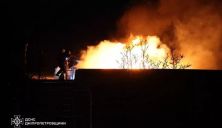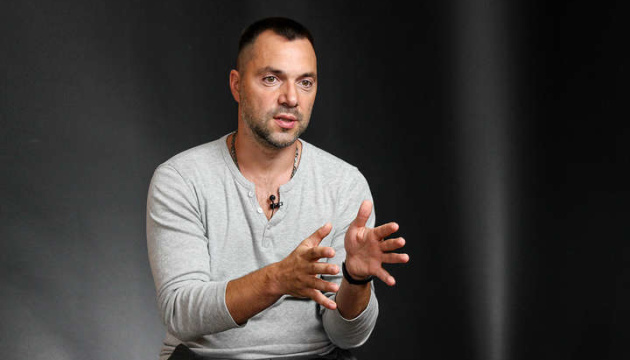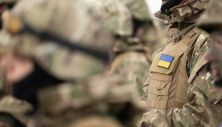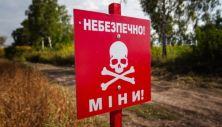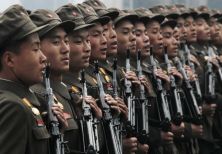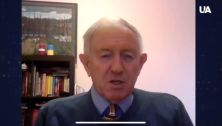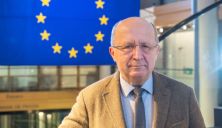What are the main results of the visit of the President of Ukraine to the United States for Donbass? What caused the aggravation on the front line. And the failure of the Kremlin’s policy.
We are talking about this in the program “View from Bankova” with the speaker of the Ukrainian delegation in the Trilateral contact group (TCG) Oleksiy Arestovych, reports UA.
Dariia Vershylenko hosts the program.
– Let’s start with the most relevant. How can you assess President Zelenskyy’s visit to Washington? Did you manage to implement everything planned?
– We managed to realize more than we planned for ourselves. That is, we have achieved the maximum. This is a normal working visit, the results of which exceeded our own expectations.
– And in what exactly?
– I will mark some important points. First, for the first time in many years, Ukraine did not come as a petitioner. That is, we did not say, “Save us and help us,” but called the problem a sore spot, and called options for joint action to solve the problem or move forward in a specific political direction.
Somebody expected that the client would come to the patronage, as we often say. In fact, the partner came to the partner. This is one of the most significant achievements.
The second achievement. If you have noticed, neither during Merkel’s visit to Washington, nor during Zelenskyy’s visit to Washington, the Minsk agreements were announced. This means a very important thing. It is not that we are abandoning the Minsk agreements. This means that the Russian Federation and the Kremlin leadership have failed to push through the Minsk agreements in their version, in which they have long tried to persuade the West collectively and individually.
In the joint declaration of President Biden and President Zelenskyy, the Minsk agreements are not mentioned at all (this is a Joint Statement on the Strategic Partnership between Ukraine and the United States, ed.). This is a very strong signal to Moscow that its policy of imposing a unilateral understanding of the Minsk agreements has failed.
– It is not clear about the Minsk agreements. It turns out that Ukraine is looking for an alternative to them?
– Here we need to understand the following. The Minsk agreements are not obligatory. The Russian Federation is directly lying to the world community, consistently throwing into the information space (including ours) that allegedly “Minsk-2” is obligatory on the decision of the UN Security Council. This is a direct lie, which has been disavowed many times, including in the UN Security Council.
In February, Leonid Makarovich [Kravchuk] took part [in a UN Security Council meeting] by video conference, and I was there. And the Russian representative was clearly quoted the English version with a translation that said “welcomes and approves” [Minsk agreements]. But the wording “welcomes and approves” does not make these agreements obligatory.
And the main sign that they are not so – there are no sanctions for non-compliance, unfortunately.
If there were sanctions for non-compliance, the Russian Federation would have long been under an even bigger package of sanctions than it is.
In addition, taking into account the Minsk agreements, agreements within the Normandy format summits, there are now 7 protocols on Donbas. The Russians prefer to remain silent about most of them. And there are very different things.
Thus, one of the protocols of September 5, 2014 (the first Minsk Protocol, the so-called Minsk-1, – ed.) states that it is necessary to create a security zone, both on the territory of Ukraine from the Russian-Ukrainian border and on the Russian territory. That is, de facto Russians are recognized as a party to the conflict. But they preferred to forget all this.
Also, our position, together with France, Germany, and the OSCE, has always been that the Normandy format is older than the Minsk format. A document signed by [the first “head of the DPR”] Zakharchenko and [the first “head of the LPR”] Plotnytskiy – one killed and the other unknown where is he hanging out – cannot be older than the collective decision of the four leaders of the Normandy format, the two sides in the conflict and so on. Do the Russians insist that Zakharchenko’s signature is bigger than Putin’s?
The Minsk agreements are not an internationally enforceable instrument. This is the voluntary consent of the parties. In addition, they are written so vaguely that the Minsk Group was set up to agree on the positions of the parties on the procedure and content of their implementation. The Russian Federation has been imposing its version for 7 years. We offered our option, and offered options for rapprochement. They did not go for it.
The world has realized that the main opponent of the Minsk agreements, the main participant in disrupting their implementation, is the Russian Federation. They stated [on September 2] that they refused to continue the OSCE mission on the Russian-Ukrainian border. From September 30, in theory, there should no longer be OSCE representatives [on the Russian checkpoints “Hukovo” and “Donetsk”] monitoring the movement of Russian troops. Why is this done? This is a direct way out of the Minsk agreements.
– If not the Minsk agreements, then by what formula can this conflict be resolved?
– The Minsk agreements did not go anywhere. The parties did not officially announce their withdrawal. But de facto everyone understands everything perfectly.
The President of Ukraine brought to the United States several options for resolving the issue – the creation of a new system of pressure on the Russian Federation in order to force it to fulfill international obligations, and these options involve the United States.
– Could you explain what format is it in more details?
– I can’t go into details, because this is not a decision yet. Consultations are underway. When this is approved, the whole world will know about it.
– Joint statement on the strategic partnership between Ukraine and the United States. What does this document give us?
– The direct and immediate consequence is a sharp increase in cooperation between our intelligence communities: information exchange, interaction, joint operations. For example, we will receive intelligence information in much larger volumes and in real time than before. This significantly increases our ability to provide early warning and target specific needs if the need arises.
In total, there are 11 points-directions. From cybersecurity to continuing Armed Forces reforms.
If to explain this agreement and the visit in general.
Imagine: there are two neighbors who live in the same village, communicate, but like this: “Hello, neighbor”, “Goodbye, neighbor”. For four years, there was no direct contact between the presidents of the United States and Ukraine. And the issue of strategic trust, of joint action has long been in limbo. And so on September 1, these neighbors sat down at the same table, talked and realized that their values and goals are the same. They have outlined a framework agreement, which they will jointly pursue in very different areas, from energy to defense, industrial development, strengthening contacts, increasing trade, and so on.
That is, a road map is drawn, which shows that we are moving here for a single purpose. The goal is a democracy that opposes authoritarian regimes.
And we are in the same military camp, we are military allies. 11 areas for the development of military cooperation. USD 2.5 billion contracts have been signed with Ukroboronprom, there will be a joint production of weapons and military equipment, which has never been before.
A special secure line of government communication between the presidents of the United States and Ukraine will also be established for ongoing consultations.
And besides, the Commission [on the Ukraine-US Strategic Partnership] is being revived – remember, there was once a Gore-Kuchma Commission, where the permanent representatives solved a lot of issues concerning 7-9 areas, it worked very effectively. And package investment in the Ukrainian economy, development, military equipment, energy security, construction of new nuclear units and so on. Everything will be decided within this commission. In particular, the part of the plan, which the President presented as the transformation of Ukraine.
– This visit was preceded by aggravation in Donbas. There was a shelling of Avdiivka. The TCG held an extraordinary meeting of the security subgroup on this issue. Are there any practical results of this meeting?
– The practical results are as follows – we have achieved from the Russians, from the Russian side, that the security subgroup is part of the coordination mechanism [on the ceasefire]. And it should verify such cases.
This verification was done, the parties acknowledged the incident. The Russian Federation recognized it, and we reminded them that according to clause “E” of the ceasefire agreement, the Ukrainian side has the right to open fire in response to such provocations, and the fire was opened. And to all fans of shooting we once again made it clear that at the next attempt to make it they will need to complain only on themselves.
– However in reports from front there were wounded again, and the killed. How long will this aggravation last?
– This is a standard Chekist story: they believe that negotiations are successful only when blood is shed during the negotiations. Any TCG meeting, any state visit, any meeting – there are always shelling and the attempts to inflict losses on us.
By the way, on August 31 and September 1 there was an annual meeting of the OSCE on the conflict of the parties, there was a separate report on Ukraine. Therefore, the shelling of Avdiivka was “timed” even before.
But the main news is that we have responded and will respond with fire. There is no army that is indifferent to losses.
And if Russian propaganda says that they don’t care, fought and will fight – it’s not true. They are experiencing this very painfully.
I can name the ratio of losses for July. According to our data, 5 Ukrainian servicemen and 22, according to their data, Russian servicemen were killed in Ukraine.
But the main news is that we have responded and will respond with fire. There is no army that is indifferent to losses.
And if Russian propaganda says that they don’t care, we fought and we will fight – it’s not true. They are experiencing this very painfully.
I can name the ratio of losses for July. According to our data, 5 Ukrainian servicemen and 22, according to their data, Russian servicemen were killed in Ukraine.
We are committed to the Minsk agreements; we are committed to the ceasefire agreements. We believe that civilians and military personnel should not perish in this conflict as long as the political and diplomatic settlement continues. But if we are shot, we will answer.
Russia tried to impose recognition of the Minsk agreements because it wanted Ukrainian society, the leadership of the United States, and Germany to succumb to the bloodshed and the suffering of those they held hostage. But nothing like that will happen. After all, neither international pressure, nor the attempt to put pressure on Ukraine, nor the attempt to put pressure on the front through blood – led to the success of their policy. Their policy failed.
Sometime in May, [Russian Foreign Minister Sergei] Lavrov gave a very hot interview on Russian television. And he said the following phrase: “We will never allow Zelenskyy and Ukraine to break the hook of the Minsk agreements.”
So, the news for Lavrov is that the hook of the Minsk agreements no longer exists, neither the Minsk agreements, nor the hook of the Minsk agreements, i.e. the Russian version of their interpretation, which they tried to impose on us and the world community. Neither the blood of civilians and the military they are trying to shed, nor did the unprecedented pressure on Ukraine, nor the intrigues against France and Germany, nor the attempts to put pressure on the OSCE, nor the attempts to use the pro-Russian lobby around President Biden help. The complete failure of Russian policy. And if we add to this the Crimean platform, then I can tell you that this round is completely behind us.
